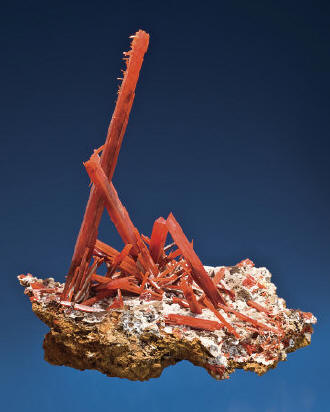
Crocoite, 8.7 cm high. Gobin specimen. J. Scovil photo.
It has been reported that only around20% of this pocket was actually recoveredintact and the rest was destroyedduring the process of extraction. It isunknown exactly how many specimensthis pocket produced but it would probablybe in the hundreds rather thanthe thousands. Of those producedonly a very small percentage were inthe upper echelon of mineral specimens.
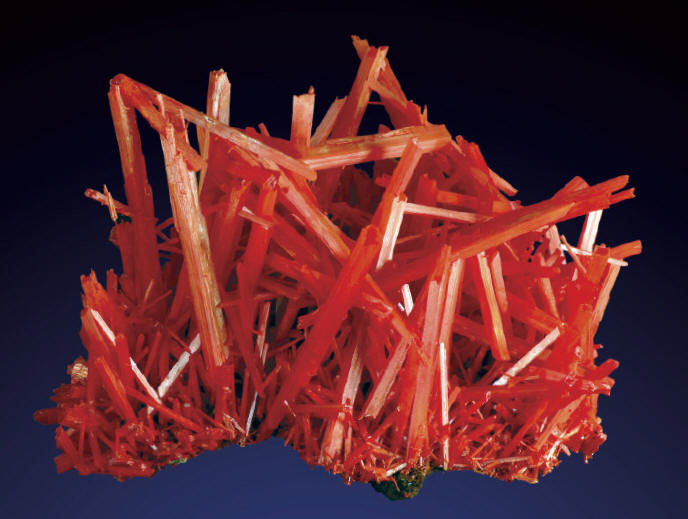
High quality crocoite specimens recovered from 2010 Pocket; size of specimen 16 cm, crystals up to 9.5 cm. A. Wright photo.
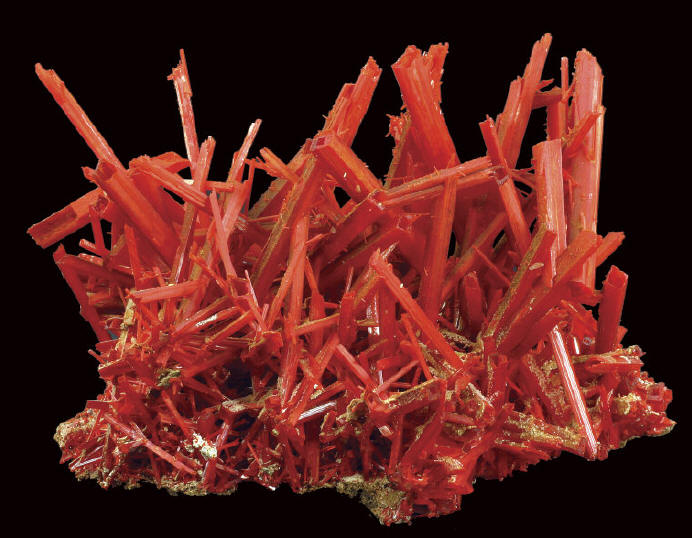
One of the best crocoite specimens recovered from 2010 Pocket; size of specimen 16,5 cm, crystals up to 10 cm. A. Wright photo.
The “1990’s Pocket” was the biggestby far at up to 1 meter wide, 14 meterslong and 10 meters deep. This pocketproduced thousands of good specimensover the roughly 10 years it took to mine.
Although there were many more specimensrecovered from this pocket thanothers, it still only yielded a very smallpercentage of top quality specimens.
The small percentage of top piecesmight be related to the method used toclean the crocoites. Anyone who visitedthe mine in the 1990’s might recall seeinga garden hose with a high pressurenozzle perched on a tree stump, blastingwater at crocoite set on an adjacent treestump. Any specimen not broken topieces eventually made it onto some collector’sshelf. The heaps of orange crystalsaround the tree stump weretestament to the fragility of the matrixpieces!
The trend of a twenty year intervalbetween big finds seems to have continuedto the present, as another greatpocket was found by TAMC in 2010.
PROGRESS OF MINING IN 2010
The mining in 2010 commenced withcompletion work on the raise started in2009, and development of a new levelfrom the top of the raise. The new drive followed the vein, going farther into thehill, with the intention of intersecting thecavity at the top of the Premiere Pocket.

Adam Wright with the best specimens from 2010 Pocket after cleaning, note size of crystals and intesity of color. E. Aheimer photo.
The vein continued to widen slightly asmining progressed both in, and up alongthe structure. The amount of visible crocoitebegan slowly increasing, andthe vein walls became more and morecavity-rich. Mining continued, rampingupwards a little following encouragingsigns of mineralization and softerground. The crocoite continued toimprove as mining progressed further,although at this stage there was still verylittle specimen quality material. Crocoitealways looks very nice in situ underground,but much of it has a matrix ofloose dirt or is not held together at all,making much of it nearly impossible torecover complete. It was at this point indevelopment that the vein ahead seemedto be getting a bit narrower, and thewalls getting a bit harder, so drifting wasdetoured up a bit higher to avoid thisrestriction. It was at this point, whileclearing out muck from the back a thicksolid seam of crocoite about 10 cm widewas exposed... the discovery of the 2010Pocket.
2010 POCKETThe new pocket, cleverly named the“2010 Pocket”, turned out to be very goodindeed. It was about 2 meters long by1 meter high and up to 45 centimeterswide. The pocket took a bit over twomonths to extract, working roughly fourdays every second week. The mining wasvery hard, dirty work, and after fourdays a break was necessary to recover.
The crystals growing off the pocketfootwall mainly formed in radiatingsprays and were better supported onmatrix, so more of the crystals survived.
The crystals which had grown on thehanging wall had their weight andphysics working against them so more ofthem seem to have fallen, leaving mainlysmaller crystals and only those biggercrystals which had grown in more gravityfriendly positions. Piles were found atthe bottom of pocket containing largenumbers of loose crystals and detritus.
It seems likely that while the first generationcrocoite crystals were growing biggerand heavier, the matrix to which theywere attached got softer and weakeruntil some of them could no longer besupported and they fell to the bottom ofthe pocket.
At some point after crystal growth,the large crocoite crystals were coatedby ferro-manganese oxides. The coating, even though it at first glance may seemto spoil the aesthetics of specimens, mayhave interrupted crystal growth andstopped the crystals from spanning thewhole space and becoming a solid seam instead of remaining an open pocket.
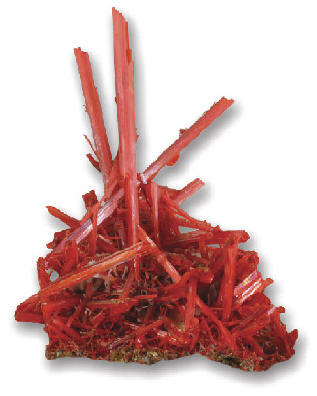
Another top quality crocoite specimen from 2010 Pocket with crystals up to 9.5 cm. A. Wright photo.
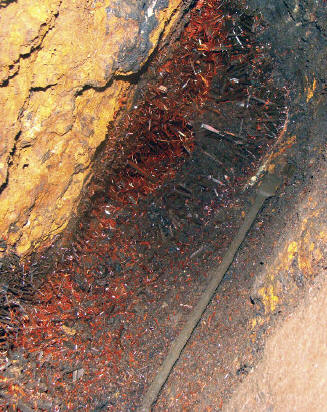
Fragment of 2010 Pocket with clean crystals of crocoite and part where crystals are covered by coating of black Fe-Mn oxides. A. Wright photo.
Over time more detritus dropped downand this accumulated mostly onto thehigher sides of the footwall’s radiatingclusters. A thin coating of dundasite andgibbsite was then deposited, mainly overthe exposed upper surfaces of the crocoitecrystals. After that, additionalferro-manganese oxides appear to havebeen added. The final stage was thegrowth of another generation of crocoitecrystals, being the small bright red crys-tals coated over the top. When this lastgrowth of crocoite occurred it also hadthe affect of rehealing many of the brokenends on the fallen crystals and theirstumps by creating multiple small terminationson their large ends.








 YueGongAnBei 44051102000467
YueGongAnBei 44051102000467


 |
|